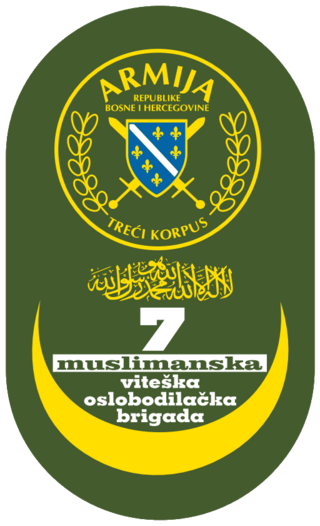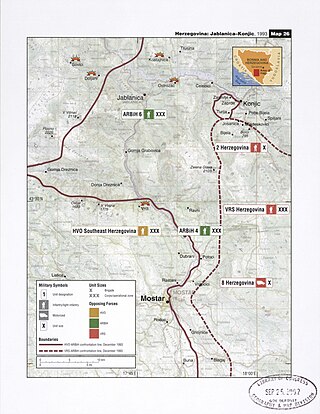
The Herzegovina-Neretva Canton is one of 10 cantons of the Federation of Bosnia and Herzegovina in Bosnia and Herzegovina.

Case White, also known as the Fourth Enemy Offensive, was a combined Axis strategic offensive launched against the Yugoslav Partisans throughout occupied Yugoslavia during World War II. It was one of the most significant confrontations of World War II in Yugoslavia. The offensive took place in early 1943, between 20 January and mid-to-late March. The Axis operation prompted the Partisan Supreme Command to enact its plans to drive toward eastern Herzegovina, Sandžak and Montenegro.

The Army of the Republic of Bosnia and Herzegovina, often referred to as Bosnian Army or Bosniak Army, was the military force of the Republic of Bosnia and Herzegovina. It was established by the government of the Republic of Bosnia and Herzegovina in 1992 following the outbreak of the Bosnian War.

The Croatian Defence Council was the official military formation of the Croatian Republic of Herzeg-Bosnia, an unrecognized state that existed in the Republic of Bosnia and Herzegovina between 1991 and 1996. The HVO was the main military force of the Croats of Bosnia and Herzegovina.

The 7th Muslim brigade was an elite all-volunteer brigade of the 3rd Corps of the Army of the Republic of Bosnia and Herzegovina. It served as the ARBiH's primary assault brigade in Central Bosnia, and was headquartered in Zenica. The brigade's manpower largely came from the cities of Zenica, Travnik, and Kakanj; however, there were soldiers from all over Bosnia who served in its ranks. During the war, the brigade liberated over 1,100 km2 of territory, including multiple cities, as well as numerous villages and mountains. Some of the most notable combat actions of the 7th Muslim brigade include the liberation of Vareš, Fojnica, Bugojno, Kakanj, and Travnik from the hands of HVO forces, as well as the defence of Mt. Igman and the liberation of liberation of Mt. Vlašić (Opaljenik), Teslić-Šerić (Jezera), Nabožić (Ilijaš), and Vozuća and the Ozren pocket from VRS forces.

Operation Neretva '93 was an Army of the Republic of Bosnia and Herzegovina (ARBiH) operation against the Croatian Defence Council (HVO) in September 1993 on a 200 km long front from Gornji Vakuf to south of Mostar, one of its largest of the year, during the Croat–Bosniak War. The ARBiH made limited gains in the area of northern Herzegovina and around Mostar, but did not achieve a breakthrough to the southern Neretva, where the HVO retained control. The operation was halted in October. During the operation, dozens of Croat civilians were killed in the Grabovica and Uzdol massacres.

The 5th Corps was one of seven corps of the Army of the Republic of Bosnia and Herzegovina. The formation was around the Bihać pocket to protect it against the surrounding Serb forces. The Fifth Corps also fought secessional Bosniak forces loyal to Fikret Abdić, who was cooperating with Serb forces. In the last military action of the ARBiH, Operation Sana, the corps defeated Abdić's supporters and brought a number of regions of Bosnia and Herzegovina under government control. In April 2018, police detained Atif Dudaković and 12 others on suspicion of committing crimes against humanity during the Bosnian war. The court process is still ongoing.

The Croat–Bosniak War was a conflict between the Republic of Bosnia and Herzegovina and the Republic of Herzeg-Bosnia, supported by Croatia, that lasted from 18 October 1992 to 23 February 1994. It is often referred to as a "war within a war" because it was part of the larger Bosnian War. In the beginning, the Army of the Republic of Bosnia and Herzegovina and the Croatian Defence Council (HVO) fought together in an alliance against the Yugoslav People's Army (JNA) and the Army of Republika Srpska (VRS). By the end of 1992, however, tensions between Bosniaks and Bosnian Croats increased. The first armed incidents between them occurred in October 1992 in central Bosnia. The military alliance continued until early 1993, when it mostly fell apart and the two former allies engaged in open conflict.

This section is about the history of the Army of the Republic of Bosnia and Herzegovina that existed from 1992 to 1995, then it was formed into two armies of the two entities from 1998 to 2005 and finally transformed into the Armed Forces of Bosnia and Herzegovina (OSBIH).

Operation Alfa was an offensive carried out in early October 1942 by the military forces of Italy and the Axis puppet state, the Independent State of Croatia (NDH), supported by Chetnik forces under the control of vojvoda Ilija Trifunović-Birčanin. The offensive was directed against the communist-led Partisans in the Prozor region, then a part of the NDH. The operation was militarily inconclusive, and in the aftermath, Chetnik forces conducted mass killings of civilians in the area.

The 6th Corps was a corps of the Army of the Republic of Bosnia and Herzegovina.
The Grabovica massacre refers to the murders of at least 13 ethnic Croat inhabitants of the village of Grabovica near Jablanica by members of the Army of the Republic of Bosnia and Herzegovina (ARBiH) 9th Brigade and other unidentified members of ARBiH on 8 or 9 September 1993. The International Court Tribunal for former Yugoslavia concluded that the number of victims totaled to be 13, lower than the alleged amount of 33.

The Croat–Bosniak War was a conflict between the Republic of Bosnia and Herzegovina and the Croatian Community of Herzeg-Bosnia, supported by Croatia, that lasted from 19 June 1992 – 23 February 1994. The Croat-Bosniak War is often referred to as a "war within a war" because it was part of the larger Bosnian War.

The Mostar Operation was a series of Yugoslav Partisan military operations in Herzegovina from February 6–15, 1945.

The Siege of Mostar was fought during the Bosnian War first in 1992 and then again later in 1993 to 1994. Initially lasting between April 1992 and June 1992, it involved the Croatian Defence Council (HVO) and the Army of the Republic of Bosnia and Herzegovina (ARBiH) fighting against the Serb-dominated Yugoslav People's Army (JNA) after Bosnia and Herzegovina declared its independence from Yugoslavia. That phase ended in June 1992 after the success of Operation Jackal, launched by the Croatian Army (HV) and HVO. As a result of the first siege around 90,000 residents of Mostar fled and numerous religious buildings, cultural institutions, and bridges were damaged or destroyed.

The Battle of Kupres was a battle of the Bosnian War, fought between the Army of the Republic of Bosnia and Herzegovina (ARBiH) and the Croatian Defence Council (HVO) on one side and the Army of Republika Srpska (VRS) on the other from 20 October to 3 November 1994. It marks the first tangible evidence of the Bosniak–Croat alliance set out in the Washington Agreement of March 1994, brokered by the United States to end the Croat–Bosniak War fought between the ARBiH and the HVO in Bosnia and Herzegovina. The ARBiH and the HVO were not coordinated at first, rather they launched separate operations aimed at capture of Kupres.

The Partisan Long March was the redeployment of Josip Broz Tito's Partisan Supreme Headquarters and the major fighting elements of the Yugoslav Partisans across the Independent State of Croatia, from south-eastern to north-western Bosnia that commenced in late June 1942. The march followed the first large-scale joint German-Italian counter-insurgency operation in the NDH, Operation Trio, and the combined Italian-Montenegrin Chetnik offensive in Montenegro and eastern Herzegovina.
The Battle of Bugojno was fought between forces of the Army of the Republic of Bosnia and Herzegovina (ARBiH) and the Croatian Defence Council (HVO) for control of the town and municipality of Bugojno in central Bosnia, from 18–28 July 1993. The area of Bugojno was under joint control of the ARBiH 307th Brigade and the HVO Eugen Kvaternik Brigade since the start of the Bosnian War. Violent incidents in Bugojno followed the escalation of the Croat-Bosniak War in adjacent municipalities throughout the 1st half of 1993. Bugojno was spared from fighting and the two local brigades were still formally allied by June 1993, at the time of an ARBiH offensive in central Bosnia.
Operation Munja 93 was a military operation conducted on January 11, 1993, by the 505th Bužim Brigade of the Army of the Republic of Bosnia and Herzegovina (ARBiH). The operation aimed to regain control of the territory in the Banjani area from the Army of Republika Srpska (VRS).
Midhad Hujdur aka Hujka was a member of the Army of the Republic of Bosnia and Herzegovina. In the First Mostar Brigade, whose commander was Arif Pašalić, Hujdur commanded a battalion numbering 1,200 fighters. When Pašalić was appointed commander of the 4th Corps, Hujdur took command of the brigade, which would later become the 41st Glorious Brigade. He was killed on June 30, 1993, in the action to unblock Mostar and was buried at the Martyrs Cemetery in Mostar.
















